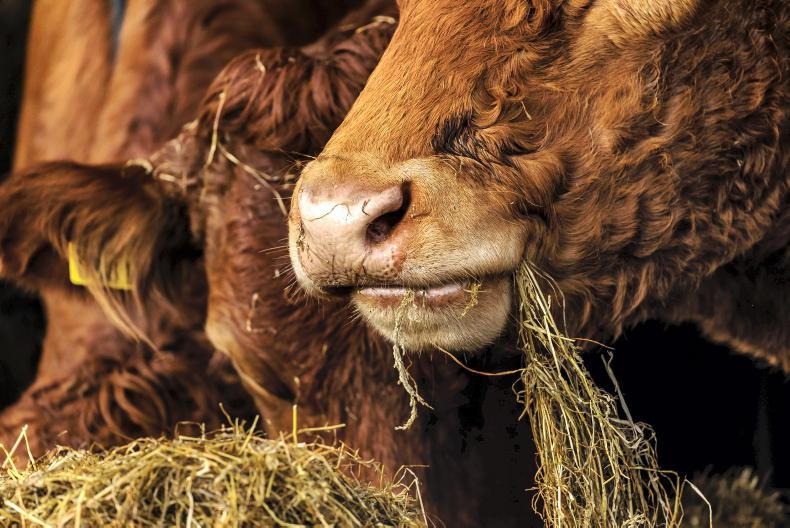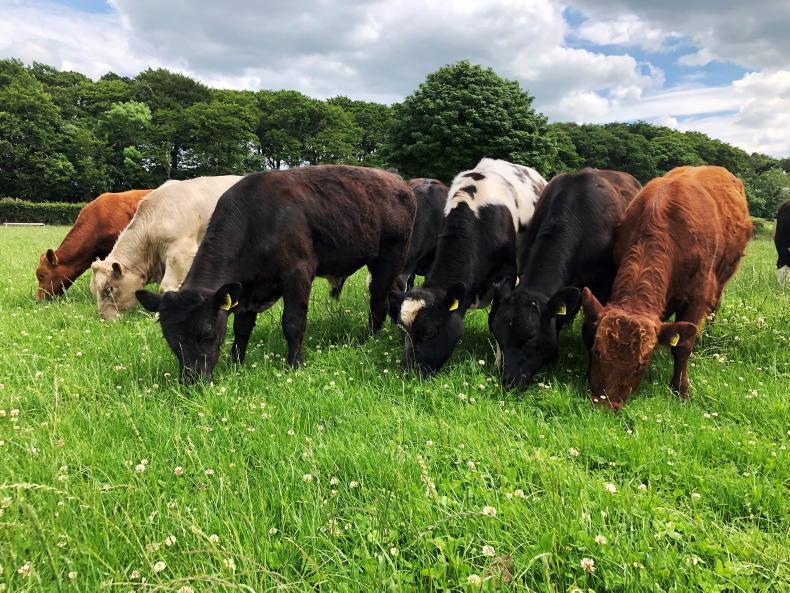The return of wet and cold weather has halted plans for turning cows and calves out to grass on many suckler farms around the country.
On farms working heavier land, cows and calves have had to be brought back indoors and this has increased pressure on housing and stocking rates in sheds. To help farmers manage, outlined are some tips for managing cows and newborn calves indoors until turnout is possible.
Target better-quality silage to lactating cows
Spring-calving cows will have an increasing demand for energy and protein in early lactation.
Therefore, target the best-quality silage on farm to these animals.
Cows in milk should be offered silage on an ad-lib basis, so make sure there is always fodder in the feed passage.
Scrape out any rejected silage on a daily basis before putting in fresh forage.
Offer the rejected silage to either dry cows or stores that will go back to grass in the weeks ahead.
Supplementary concentrate
In addition to silage, offer cows some form of concentrate to boost milk production and help lactating animals hold body condition.
A balanced ration will also provide minerals, although when feeding low levels of meal, offering additional trace elements may be beneficial.
If silage is above 70% DMD, feeding 1kg to 1.5kg/cow will suffice and help stretch out fodder supplies.

If silage quality is poor rehoused cows that are sucking calves will need concentrate supplementation while back indoors.
With silage at 67% to 70% DMD, offer 2kg/cow on a daily basis, rising to 3kg/cow where silage drops below 66% DMD.
Where housing allows, there are some cows that should be grouped separately for additional feeding.
Separating these cows will also provide extra feed space and prevent bullying.
Cows to prioritise include first-calved heifers, older animals lacking body condition and cows with twins.
Ideally, cows with calves at foot will be housed on slats, with a separate bedded creep area for calves. Make sure creep pens are dry and regularly topped up with fresh straw.
Run a hand scraper over slats during the day. This can help reduce soiling around the udder as cows lie and ruminate. Clipping tails on cows can also keep udders clean.
Empty out water troughs if they become soiled with dung or forage. Cows should always have clean drinking water available at all times.
Until turnout is possible, stocking density will increase in sheds. As it does, the requirement for good ventilation becomes even more important to reduce the risk of disease.
Pay attention to airflow in sheds. Stale, humid air or a strong smell of ammonia are obvious signs of poor airflow, as are cattle having damp, dirty coats.
Cow numbers should be tailored to match feeding space, particularly if you are only offering 1kg to 2kg/head.
If all cows cannot access feed at the same time, there will be cows that get no meal and others that get double their allocation.
To relieve stocking pressure, setting up temporary accommodation in roofed silos or handling units can help.
In addition, setting up a creep area in a feed passage or handling pen also helps to free up more pen space for cows.
Weather delays turnout on Tullamore Farm
Like all other parts of the country, March has been an unbelievably wet month on Tullamore Farm with over three times the February 2023 rainfall already having fallen on the farm in March. This coincides with turnout on the farm so it has disrupted plans a lot, especially in the last seven days.

Weanlings should be the first group of animals targeted for turnout as soon as ground conditions improve.
There are currently 66 cows calved on the farm with 65 live calves on the ground. Cows have all been calving with little assistance with calves requiring very little help in terms of sucking, etc.
The plan would normally be to get cows and calves out in small batches but weather over the last week has disrupted these plans. One saving grace has been the new shed which was built in 2022. It is a four-bay slatted shed with a large lieback area behind the slats and this has meant cows and calves have been able to move into these large loose pens over the last few days.
Temporary creep areas
In other years, temporary creep areas had to be constructed in some of the centre passages in the sheds. This meant that stocking rate on the slats had to be reduced as feeding space was reduced.
Farm manager Shaun Diver said: “We’re lucky in that we still have a good bit of straw left, so we have upped the usage over the last few days to avoid any issues occurring in any of the sheds. When stocking rate increases in sheds, that’s where problems can occur and we don’t want any problems. Sheds can also be harder to bed in very wet weather.”
“There are about 15 cows left to calve on the farm with a lot of these cows expected to calve in the next two weeks. We actually have a nice cover of grass on some paddocks. We got out with slurry in early February and that has meant paddocks have kicked on. It’s just ground conditions beating us at the moment. Things can change very quickly at this time of year though and if we get a dry couple of days we will go back to turning out stock again,” Shaun said.
The return of wet and cold weather has halted plans for turning cows and calves out to grass on many suckler farms around the country.
On farms working heavier land, cows and calves have had to be brought back indoors and this has increased pressure on housing and stocking rates in sheds. To help farmers manage, outlined are some tips for managing cows and newborn calves indoors until turnout is possible.
Target better-quality silage to lactating cows
Spring-calving cows will have an increasing demand for energy and protein in early lactation.
Therefore, target the best-quality silage on farm to these animals.
Cows in milk should be offered silage on an ad-lib basis, so make sure there is always fodder in the feed passage.
Scrape out any rejected silage on a daily basis before putting in fresh forage.
Offer the rejected silage to either dry cows or stores that will go back to grass in the weeks ahead.
Supplementary concentrate
In addition to silage, offer cows some form of concentrate to boost milk production and help lactating animals hold body condition.
A balanced ration will also provide minerals, although when feeding low levels of meal, offering additional trace elements may be beneficial.
If silage is above 70% DMD, feeding 1kg to 1.5kg/cow will suffice and help stretch out fodder supplies.

If silage quality is poor rehoused cows that are sucking calves will need concentrate supplementation while back indoors.
With silage at 67% to 70% DMD, offer 2kg/cow on a daily basis, rising to 3kg/cow where silage drops below 66% DMD.
Where housing allows, there are some cows that should be grouped separately for additional feeding.
Separating these cows will also provide extra feed space and prevent bullying.
Cows to prioritise include first-calved heifers, older animals lacking body condition and cows with twins.
Ideally, cows with calves at foot will be housed on slats, with a separate bedded creep area for calves. Make sure creep pens are dry and regularly topped up with fresh straw.
Run a hand scraper over slats during the day. This can help reduce soiling around the udder as cows lie and ruminate. Clipping tails on cows can also keep udders clean.
Empty out water troughs if they become soiled with dung or forage. Cows should always have clean drinking water available at all times.
Until turnout is possible, stocking density will increase in sheds. As it does, the requirement for good ventilation becomes even more important to reduce the risk of disease.
Pay attention to airflow in sheds. Stale, humid air or a strong smell of ammonia are obvious signs of poor airflow, as are cattle having damp, dirty coats.
Cow numbers should be tailored to match feeding space, particularly if you are only offering 1kg to 2kg/head.
If all cows cannot access feed at the same time, there will be cows that get no meal and others that get double their allocation.
To relieve stocking pressure, setting up temporary accommodation in roofed silos or handling units can help.
In addition, setting up a creep area in a feed passage or handling pen also helps to free up more pen space for cows.
Weather delays turnout on Tullamore Farm
Like all other parts of the country, March has been an unbelievably wet month on Tullamore Farm with over three times the February 2023 rainfall already having fallen on the farm in March. This coincides with turnout on the farm so it has disrupted plans a lot, especially in the last seven days.

Weanlings should be the first group of animals targeted for turnout as soon as ground conditions improve.
There are currently 66 cows calved on the farm with 65 live calves on the ground. Cows have all been calving with little assistance with calves requiring very little help in terms of sucking, etc.
The plan would normally be to get cows and calves out in small batches but weather over the last week has disrupted these plans. One saving grace has been the new shed which was built in 2022. It is a four-bay slatted shed with a large lieback area behind the slats and this has meant cows and calves have been able to move into these large loose pens over the last few days.
Temporary creep areas
In other years, temporary creep areas had to be constructed in some of the centre passages in the sheds. This meant that stocking rate on the slats had to be reduced as feeding space was reduced.
Farm manager Shaun Diver said: “We’re lucky in that we still have a good bit of straw left, so we have upped the usage over the last few days to avoid any issues occurring in any of the sheds. When stocking rate increases in sheds, that’s where problems can occur and we don’t want any problems. Sheds can also be harder to bed in very wet weather.”
“There are about 15 cows left to calve on the farm with a lot of these cows expected to calve in the next two weeks. We actually have a nice cover of grass on some paddocks. We got out with slurry in early February and that has meant paddocks have kicked on. It’s just ground conditions beating us at the moment. Things can change very quickly at this time of year though and if we get a dry couple of days we will go back to turning out stock again,” Shaun said.








 This is a subscriber-only article
This is a subscriber-only article











SHARING OPTIONS: